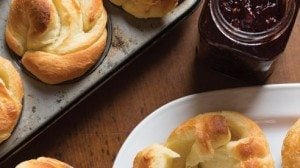This recipe requires patience – and not much more. It’s easy to make, requires no kneading and the reward for waiting lies between the tender layers in the lightest of dinner rolls. The method involves a long, slow, cold ferment of the dough. In bread making, this wait allows the gluten forming to calm down, relax and helps develop flavor.
Ingredients
- 2 .25-ounce packages active dry yeast
- 1/2 cup sugar
- 1 1/4 cups warm water between 105 degrees F and 115 F
- 1 cup unsalted butter softened
- 3 eggs
- 4 1/2 cups flour
- 2 teaspoons salt
Directions
Dissolve the yeast in ¼ cup warm water. Set aside. Using an electric mixer, cream the sugar and ½ cup of the butter together for 5 minutes. Add the one remaining cup water, eggs and yeast mixture and combine well. Gradually stir in the flour and salt. (If the mixer cannot handle the dough, stir in the flour with a wooden spoon.) Cover with plastic wrap and refrigerate overnight or up to two days.
Three hours before baking, roll the dough into a rectangle shape, about 18 x 12 inches. Spread the remaining softened butter on the surface. Starting on the long edge of the dough, roll up. Cut the roll into 24 pieces and place in prepared muffin tins. Cover with a cloth and let rise for 3 hours.
Preheat the oven to 400 degrees. Brush the tops of the rolls with melted butter and bake for 10 minutes.
Makes about 24 rolls.
Photo by Jodi Miller


